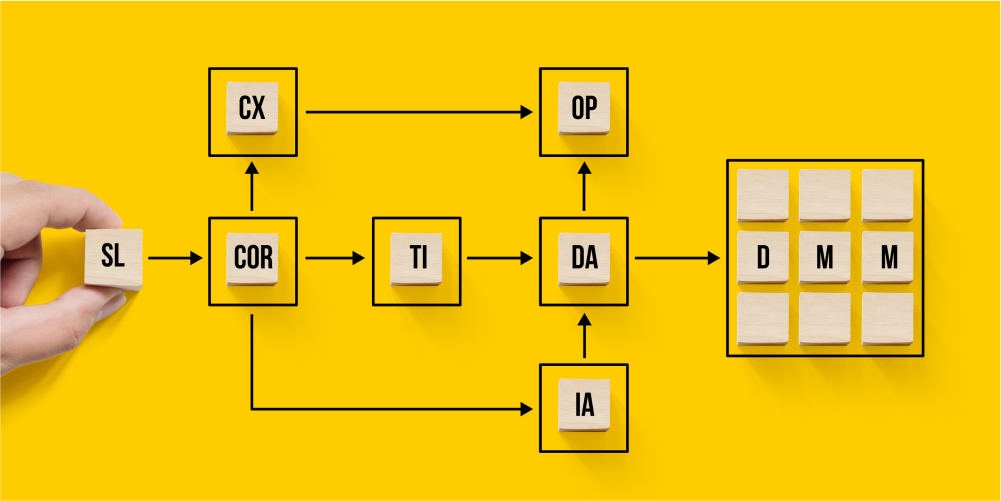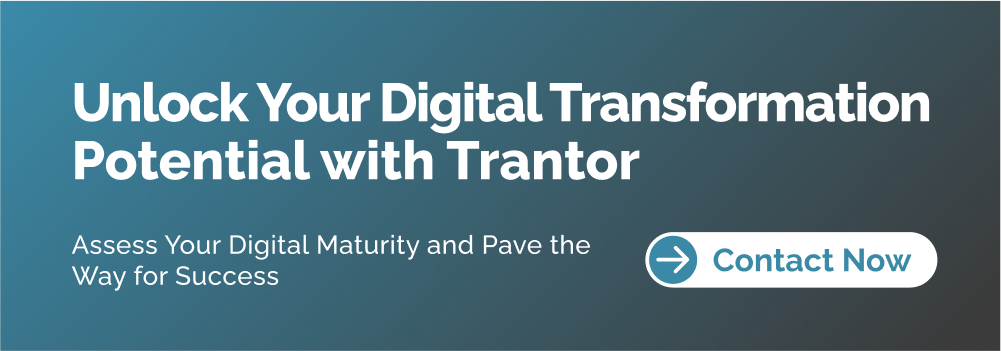Digital Transformation, zBlog
Digital Maturity Model Approach: Unlocking Digital Transformation Success

In today’s rapidly evolving digital landscape, organizations across industries are grappling with the imperative to transform their operations, processes, and business models to remain competitive and relevant. However, embarking on a digital transformation journey without a clear roadmap and understanding of an organization’s current digital maturity can be a recipe for failure.
Enter the digital maturity model – a strategic framework that provides a structured approach to assessing an organization’s digital capabilities, identifying gaps, and charting a path toward achieving desired digital maturity levels. This powerful tool has emerged as an invaluable asset for organizations seeking to navigate the complexities of digital transformation and unlock sustainable success.
In this comprehensive blog, we’ll delve into the nuances of the digital maturity model, exploring its key components, benefits, and practical applications. Whether you’re just beginning your digital transformation journey or seeking to optimize existing initiatives, this guide will equip you with the knowledge and insights needed to leverage the power of digital maturity assessments.
Understanding the Digital Maturity Model

At its core, the digital maturity model is a diagnostic tool that evaluates an organization’s digital capabilities across various dimensions, such as strategy, culture, processes, technology, data management, and customer experience. It provides a structured framework for identifying strengths, weaknesses, and opportunities for improvement, enabling organizations to prioritize their digital transformation efforts and allocate resources more effectively.
The digital maturity model typically consists of multiple maturity levels, each representing a distinct stage of digital transformation progression. These levels range from the initial or ad-hoc stage, where digital initiatives are fragmented and siloed, to the optimized or transformed stage, where digital capabilities are fully integrated and aligned with business objectives.
By assessing an organization’s current maturity level across various dimensions, the digital maturity model provides a comprehensive view of the organization’s digital readiness, highlighting areas that require immediate attention and areas where the organization excels. This holistic perspective empowers decision-makers to develop targeted strategies and roadmaps tailored to their organization’s unique needs and aspirations.
Key Components of the Digital Maturity Model

While the specific components and dimensions of digital maturity models may vary across different frameworks, several core elements are typically included:
- Strategy and Leadership: This dimension evaluates the organization’s digital vision, strategy, and leadership alignment. It assesses the extent to which digital initiatives are driven by a clear strategic direction and supported by executive buy-in and commitment.
- Culture and Organizational Readiness: A successful digital transformation requires a culture that embraces change, fosters innovation, and empowers employees. This component examines the organization’s readiness for digital transformation, including factors such as employee mindset, collaboration, and resistance to change.
- Customer Experience: In the digital age, delivering exceptional customer experiences is paramount. This dimension evaluates the organization’s ability to understand customer needs, leverage digital channels for engagement, and continuously enhance the customer journey.
- Operational Processes: Digital transformation often necessitates the optimization and automation of processes to improve efficiency and agility. This component assesses the maturity of the organization’s operational processes, including their integration with digital technologies and data management capabilities.
- Technology and Infrastructure: The digital maturity model evaluates the organization’s technological landscape, including the adoption of emerging technologies, integration of systems, data management capabilities, and cybersecurity measures.
- Data and Analytics: Data is the fuel that powers digital transformation. This dimension assesses the organization’s ability to collect, manage, and derive insights from data, as well as the integration of analytics into decision-making processes.
- Innovation and Agility: Successful digital transformation requires a culture of continuous innovation and the ability to adapt quickly to changing market dynamics. This component evaluates the organization’s agility, experimentation mindset, and capacity for rapid iteration and deployment.
Benefits of Leveraging the Digital Maturity Model

Implementing a digital maturity model offers numerous benefits to organizations embarking on digital transformation initiatives:
- Objective Assessment: The digital maturity model provides an objective and structured approach to evaluating an organization’s digital capabilities, eliminating bias and ensuring a comprehensive assessment across all relevant dimensions.
- Gap Identification: By identifying gaps and areas for improvement, the digital maturity model enables organizations to prioritize their efforts and allocate resources more effectively, maximizing the impact of their digital transformation initiatives.
- Benchmarking and Comparison: Many digital maturity models include industry benchmarks, allowing organizations to compare their digital maturity levels against peers and competitors, providing valuable insights for strategic decision-making.
- Roadmap Development: Based on the assessment results, the digital maturity model can inform the development of a detailed roadmap, outlining the steps and initiatives required to achieve desired maturity levels and digital transformation goals.
- Continuous Improvement: The digital maturity model is not a one-time exercise; it can be utilized as an ongoing assessment tool to monitor progress, adjust strategies, and drive continuous improvement throughout the digital transformation journey.
- Stakeholder Alignment: By providing a common language and framework, the digital maturity model facilitates stakeholder alignment and buy-in, ensuring that all parties share a consistent understanding of the organization’s digital transformation objectives and priorities.
Implementing the Digital Maturity Model

Leveraging the digital maturity model effectively requires a structured and disciplined approach. Here are the typical steps involved in implementing a digital maturity assessment:
- Select a Digital Maturity Framework: Choose a digital maturity framework that aligns with your organization’s industry, size, and specific digital transformation goals. Popular frameworks include the MIT Sloan Digital Maturity Model, the Deloitte Digital Maturity Model, and the IDC Digital Transformation Framework, among others.
- Establish Assessment Criteria: Define the specific criteria and metrics that will be used to evaluate each dimension of the digital maturity model. This may involve customizing the framework to align with your organization’s unique context and requirements.
- Data Collection: Gather relevant data and information from various sources, including interviews with key stakeholders, surveys, workshops, and documentation reviews. Ensure that data collection is comprehensive and representative of all relevant functions and departments.
- Maturity Level Assessment: Analyze the collected data and assess the organization’s current maturity level across each dimension of the digital maturity model. This may involve scoring or rating the organization’s performance against predefined criteria.
- Gap Analysis and Prioritization: Identify gaps and areas for improvement by comparing the organization’s current maturity levels against desired target levels or industry benchmarks. Prioritize initiatives and allocate resources based on the identified gaps and strategic objectives.
- Roadmap Development: Develop a detailed roadmap outlining the specific initiatives, timelines, and resources required to address the identified gaps and achieve the desired digital maturity levels. Ensure that the roadmap is aligned with the organization’s overall digital transformation strategy.
- Implementation and Continuous Monitoring: Execute the roadmap initiatives, continuously monitor progress, and make necessary adjustments based on changing circumstances or emerging opportunities. Regularly reassess the organization’s digital maturity levels to track progress and identify new areas for improvement.
- Stakeholder Engagement and Communication: Engage stakeholders throughout the process, communicate progress and results transparently, and foster a culture of continuous learning and improvement. Celebrate successes and use setbacks as opportunities for growth and adaptation.
Integrating the Digital Maturity Model with Other Frameworks

While the digital maturity model provides a powerful framework for assessing and guiding digital transformation initiatives, it is often used in conjunction with other complementary methodologies and frameworks. For example, organizations may integrate the digital maturity model with agile project management frameworks, such as Scrum or Kanban, to ensure efficient and iterative execution of digital initiatives.
Additionally, the digital maturity model can be aligned with established business transformation frameworks like the Balanced Scorecard or the TOGAF Enterprise Architecture framework, ensuring that digital transformation efforts are aligned with broader organizational goals and strategies.
Conclusion
In the rapidly evolving digital landscape, organizations that fail to embrace digital transformation risk being left behind. The digital maturity model offers a structured and comprehensive approach to assessing an organization’s digital capabilities, identifying gaps, and charting a path toward achieving desired digital maturity levels.
By leveraging the digital maturity model, organizations can gain a holistic understanding of their digital readiness, prioritize initiatives, and develop tailored roadmaps for successful digital transformation. However, it’s important to remember that the digital maturity model is not a one-size-fits-all solution; it should be customized and adapted to align with an organization’s unique context, industry, and strategic objectives.
Embarking on a digital transformation journey can be daunting, but organizations don’t have to go it alone. Trantor, a leading digital transformation firm, offers expert guidance and support in implementing digital maturity assessments and developing tailored digital transformation strategies.
With Trantor’s expertise and the power of digital transformation consulting services, organizations can navigate the complexities of digital transformation with confidence, unlocking new opportunities for innovation, growth, and competitive advantage in the digital age.




